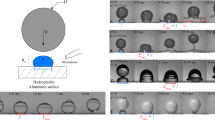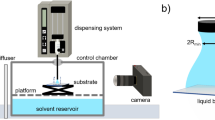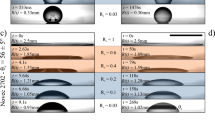Abstract
Controlling the impact of drops onto solid surfaces is important for a wide variey of coating and deposition processes—for example, the treatment of plants with herbicides and pesticides requires precise targeting in order to meet stringent toxicological regulations. However, the outer wax-like layer of the leaves is a non-wetting substrate that causes sprayed droplets to rebound; often less than 50% of the initial spray is retained by the plant1. Although the impact and subsequent retraction of non-wetting aqueous drops on a hydrophobic surface have been the subjects of extensive experimental and theoretical work2,3,4,5,6,7, non-newtonian rheological effects have not been considered in any detail. Here we report that, by adding very small amounts of a flexible polymer to the aqueous phase, we can inhibit droplet rebound on a hydrophobic surface and markedly improve deposition without significantly altering the shear viscosity of the solutions. Our results can be understood by taking into account the non-newtonian elongational viscosity, which provides a large resistance to drop retraction after impact, thereby suppressing droplet rebound.
This is a preview of subscription content, access via your institution
Access options
Subscribe to this journal
Receive 51 print issues and online access
$199.00 per year
only $3.90 per issue
Buy this article
- Purchase on Springer Link
- Instant access to full article PDF
Prices may be subject to local taxes which are calculated during checkout




Similar content being viewed by others
References
Wirth, W., Storp, S. & Jacobsen, W. Mechanisms controlling leaf retention of agricultural spray solutions. Pest. Sci. 33, 411– 422 (1991).
Chandra, S. & Avedisian, C. T. On the collision of a droplet with a solid surface. Proc. R. Soc. Lond. A 432, 13–41 (1991).
Rein, M. Phenomena of liquid drop impact on solid and liquid surfaces. Fluid Dynamics Res. 12, 61–93 ( 1993).
Fukai, J. et al. Wetting effects on the spreading of a liquid droplet colliding with a flat surface: experiment and modeling. Phys. Fluids 7, 236–247 (1995).
Bennett, T. & Poulikakos, D. Splat–quench solidification: estimating the maximum spreading of a droplet impacting a solid surface. J. Mater. Sci. 28, 963–970 (1993).
Scheller, B. L. & Bousfield, D. W. Newtonian drop impact with a solid surface. Am. Inst. Chem. Eng. J. 41, 1357–1367 (1995).
Mao, T., Kuhn, D. & Tran, H. Spread and rebound of liquid droplets upon impact on flat surfaces. Am. Inst. Chem. Eng. J. 43, 2169–2179, (1997).
de Gennes, P. G. Wetting: statics and dynamics. Rev. Mod. Phys. 57, 827–863 (1985).
Hayes, R. A. & Ralston, J. Forced liquid movement on low energy surfaces. J. Colloid Interface Sci. 159, 429–438 (1993).
Hudson, N., & Jones, T. The A1 projet—an overview. J. Non-Newtonian Fluid Mech. 46, 69– 88 (1993).
Dontula, P., Pasquali, M., Scriven, L. E. & Macosko, C. W. Can extensional viscosity be measured with opposed-nozzle devices? Rheol. Acta 36, 429–448 (1997).
Bird, R. B., Armstrong, R. C. & Hassager, O. in Dynamics of Polymeric Liquids Vols 1, 2, pp 495–520 (Wiley, New York, 1987).
Tanner, R. I. in Engineering Rheology 168–224 (Clarendon, Oxford, 1992).
Bergeron, V., Martin, J. -Y. & Vovelle, L. Utilisation de polymères comme agents anti-rebond dan des formulations mises en æuvre en milieux aqueux. French Patent Application 9810471 (1998); International Extension PCT/FR99/02002 (1999).
Yerushalmi-Rozen, R., Klein, J. & Fetters, L. J. Suppression of rupture in thin, nonwetting liquid films. Science 263, 793– 795 (1994).
Yerushalmi-Rozen, R. & Klein, J. Stabilization of non-wetting thin liquid films on a solid substrate by polymeric additives. Langmuir 11, 2806–2814 (1995).
Acknowledgements
D.B. thanks S. Kumar for helpful discussions; and J. Vermant and P. Moldenaers for help with the elongational viscosity measurements. LPS de l’ENS is UMR 8550 of the CNRS, associated with the universities Paris 6 and 7. We also thank the European Commission for their support in the form of TMR project funding.
Author information
Authors and Affiliations
Corresponding author
Rights and permissions
About this article
Cite this article
Bergeron, V., Bonn, D., Martin, J. et al. Controlling droplet deposition with polymer additives. Nature 405, 772–775 (2000). https://doi.org/10.1038/35015525
Received:
Accepted:
Issue Date:
DOI: https://doi.org/10.1038/35015525
This article is cited by
-
Suppression of hollow droplet rebound on super-repellent surfaces
Nature Communications (2023)
-
Efficient mesh-free modeling of liquid droplet impact on elastic surfaces
Engineering with Computers (2023)
-
Printed Solid-State Batteries
Electrochemical Energy Reviews (2023)
-
Evaporation Characteristics and Morphological Evolutions of Fuel Droplets After Hitting Different Wettability Surfaces
Journal of Bionic Engineering (2023)
-
Penetration and ligament formation of viscoelastic droplets impacting on the superhydrophobic mesh
Scientific Reports (2022)
Comments
By submitting a comment you agree to abide by our Terms and Community Guidelines. If you find something abusive or that does not comply with our terms or guidelines please flag it as inappropriate.



